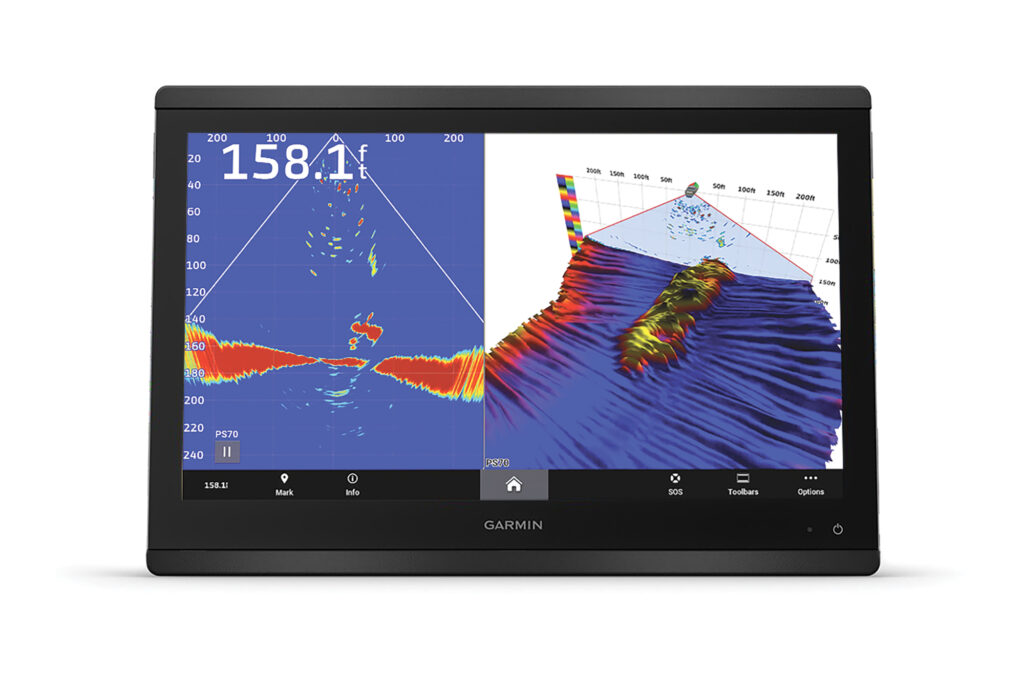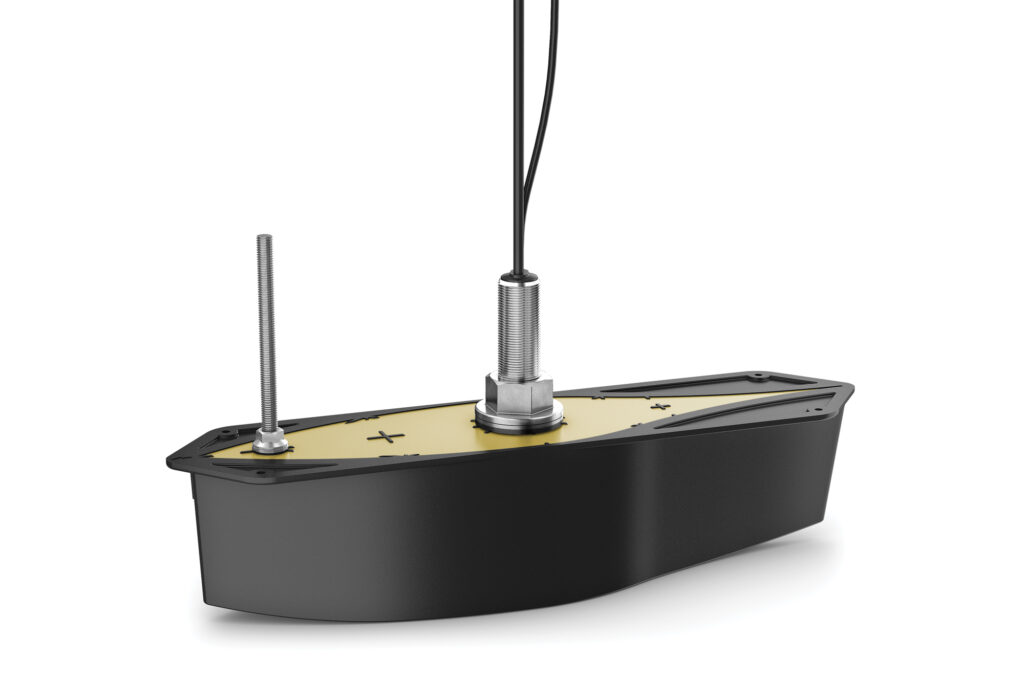Garmin’s PS70 Transducer Sees All
 Garmin’s PS70 provides downward-looking live sonar imagery to compatible Garmin multifunction displays.
Courtesy Garmin
Garmin’s PS70 provides downward-looking live sonar imagery to compatible Garmin multifunction displays.
Courtesy Garmin
Use the right acoustics, and familiar waters reveal their secrets. Just ask Dave DeVos, who’s been fishing the same waters off Port Canaveral, Florida, for years aboard his Contender 28. DeVos thought he knew all the honey holes separating his marina from the offshore depths; after all, he’s long run similar tracks with chirp on his traditional sonar.
DeVos works as Garmin’s senior manager for marine sales and support. That’s why he got to test one of Garmin’s first Panoptix PS70 transducers—and that’s when his game changed.
“The PS70’s got such a wide sonar cone, I saw a half-dozen spots I didn’t know existed,” he says.
His reward? Big catch-and-release red snapper and newfound local knowledge.
The PS70 isn’t Garmin’s first foray into live sonar, but the Olathe, Kansas-based company’s newest transducer is smaller than its predecessors, and it sends far more power and more-frequent transmissions through the water. The result is video-style onscreen presentations across four operating modes.
The PS70 is a multibeam phased-array sonar transducer broadcasting on the 190-to-210-kilohertz frequencies and transmitting at 800 watts. It has a 120-degree (port to starboard) by 8-degree (bow to stern) sonar cone that yields live imagery down to 1,000 feet in salt water. The PS70 ($4,800) comes potted in a stainless-steel through-hull transducer that can be purchased with an optional fairing block ($200). The combined transducer and fairing displaces 10.12 pounds and measures 8.5-by-4.5-by-9.6 inches, ostensibly making it an easy refit.
The PS70 has an embedded altitude heading reference system sensor, which stabilizes live sonar imagery on rough waters. It works at all speeds, so long as there’s clean water below the transducer.
 Garmin’s PS70 is a multibeam phased-array transducer that transmits at 800 watts and offers four operating modes.
Courtesy Garmin
Garmin’s PS70 is a multibeam phased-array transducer that transmits at 800 watts and offers four operating modes.
Courtesy Garmin
“If you’re reef- or wreck-fishing, you can pull up and see if there are any fish before you throw your gear over,” says Dave Dunn, Garmin’s senior director of marine and RV sales. “You can look for pelagic fish with traditional sonar, but that’s historical imagery, so the fish might not still be under you.”
The PS70 sports Garmin’s proprietary RapidReturn feature, which Dunn says is like chirp sonar on steroids. While chirp sonars transmit across a sweep of frequencies, they only send out a single sweeping pulse with each transmission. “RapidReturn sends out multiple pings at the same time across its frequencies,” Dunn says. “It’s six to eight times faster than chirp. It makes a big difference in deep water.”
The PS70’s four modes each have RapidReturn. The modes start with Traditional Sonar, which provides similar imagery to other 50/200 kHz chirp-enabled sonars. Triple-Beam Sonar bifurcates the PS70’s 120-degree sonar cone into three 40-degree segments (port, center and starboard), allowing users to view all three simultaneously or focus on one 40-degree swath. LiveVu Down provides a single 120-degree real-time view of everything below the transducer, while RealVu 3D Historical uses recent sonar returns to paint a 3D image of the grounds that were just covered, from the bottom structure to the water’s surface.
“With RealVu 3D Historical, if you want to see the bottom structure, it will draw a representation of the bottom,” Dunn says. “You can survey the entire area so that you can see where you want to cast, and you can also see anomalies.”
Combined, the PS70’s modes provide a great deal of underkeel awareness; however, the transducer’s imagery focuses downward, not forward. “Our PS51 transducer provides forward-looking sonar,” Dunn says. “Users could pair a PS70 and a PS51 and see everything.”
Another interesting pairing, he says, involves Furuno’s line of Omni sonars, which provide 360-degree scanning sonar returns. This combination joins Furuno’s scanning-sonar technology and Garmin’s live sonar, either on separate screens or in a split-screen presentation.
“We work with Furuno,” Dunn says. “PS70 and Omni systems are complementary. It’s not necessarily one or the other. It can be both.” Tournament fishermen were the first users to create this pairing, but the combination is also useful for surveying seafloor structure.
While Garmin designed the PS70 for serious anglers, Dunn says its RealVu 3D Historical returns are also useful for divers. “If there’s a wreck, you can clearly see the bow and stern,” he says, adding that this capability can help users plan their dives, especially if it’s their first visit to the site.
Additionally, the PS70 supports Garmin’s QuickDraw Contours feature, part of Garmin’s ActiveCaptain ecosystem. “It’s user-generated bathymetry,” Dunn says, adding that users can save bathymetry data for up to 50,000 acres on their Garmin multifunction display’s microSD card. “If you have a Navionics subscription, you get daily cartography updates, but some areas aren’t updated. You need local knowledge to run these waters. But with QuickDraw, if you’ve been there before, you know where the shallows are, which is useful if you have to do this in the dark or in bad weather.”
Users can anonymously share their bathymetric data with Garmin, allowing Garmin to incorporate the data into Navionics updates, or the data can remain private.
While the PS70 offers a lot, it’s not without its downsides. The PS70 is Garmin’s second-most-expensive transducer, and while its RapidReturn feature yields much faster return rates than standard chirp transducers, its onscreen frame rate ultimately hinges on how fast the paired screen redraws imagery. That means anyone cruising or fishing with older glass might need to refresh the display for real-time returns.
But for anyone who casts, cruises or dives with a Garmin MFD and is interested in real-time sonar imagery, the PS70 delivers a lot of underkeel knowledge. It can help skippers find hidden honey holes or interesting dive areas along commonly cruised routes.
Selective StalkingThe PS70 provides live imagery down to 1,000 feet, and it’s often helpful for finding the baitfish that pelagic species hunt. A smart trick, the experts say, is to adjust the gain and depth to target the upper third of the water column.
Take the next step: garmin.com
The post Garmin’s PS70 Transducer Sees All appeared first on Yachting.
- Home
- About Us
- Write For Us / Submit Content
- Advertising And Affiliates
- Feeds And Syndication
- Contact Us
- Login
- Privacy
All Rights Reserved. Copyright , Central Coast Communications, Inc.